Contents
2. When should one perform Mahalaya Shraddha during the Pitrupaksha?
3. Preparation for the ritual of Mahalaya Shraddha
3.1 Substances required for the Mahalaya Shraddha
3.2 Preparation for the person performing Shraddha
3.3 Religious actions to be performed before the main ritual
3.4 The welcome of the priest and Annaprokshan
3.5 Invocation and worship of Vishvedev
3.6 Invocation and worship of the ancestors
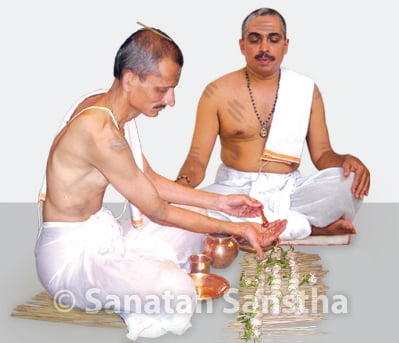
Mahalaya Shraddha
1. Deities of Shraddha
Our deceased ancestors could be in various forms of being and they need food according to that form of being. Except in the Earth region, food is unavailable in any other subtle region. In the ritual of Mahalaya Shraddha, Vasu, Rudra and Aditya are the presiding Deities of the deceased ancestors. Vasu means desire, Rudra means dissolution and Aditya means Absolute Fire Principle and action. With the combination of the three, the father, grandfather and great grandfather respectively can be liberated.
The mission associated with the presiding Deities of the departed ancestors
| Presiding Deity of the departed ancestors |
Associated mission |
| Vasu | Desire |
| Rudra | Dissolution |
| Aditya | Action |
During the ritual of Shraddha the Vishvedevs called Pururav-Ardrav and Dhurilochan are also invoked. Vishvedev means the ‘group of Deities which represents the Deities during a sacrificial fire’.
2. When should one perform Mahalaya Shraddha during the Pitrupaksha?
The Mahalay Shraddha is performed on the tithi of the death of the father of the person doing Shraddha during Pitrupaksha. If the tithi is not known, perform the Shraddha on the no moon day (Amavasya) of the month of Bhadrapad according to the Shaka Samvat and according to Vikram Samvat on the Amavasya of the month of Ashwin.
3. Preparation for the ritual of Mahalaya Shraddha
The person performing the Shraddha and the person invited for the meal to be offered to brahmin should not take meals and avoid physical relations with a woman on the previous night of the day of Shraddha. As far as possible the Shraddha should be performed on the ground floor of the residence. The venue of the Shraddha ritual should be clean.
3.1 Substances required for the Mahalaya Shraddha
First collect the list of substances required for the Mahalaya Shraddha from the ritual booklets or the priest invited for the ritual. As far as possible collect all the instruments one day in advance. The substances essential for this ritual other than the normal substances required for a ritualistic worship are – barley, black sesame seeds, maize and basil leaves. Nowadays, two priests are invited for the ritual. One priest sits facing the north which is the place of the ancestors. The other priest sits facing the east which is the place of Gods. The person performing the Shraddha sits facing the south-east. One more place is made for the priest narrating the ritual.
3.2 Preparation for the person performing Shraddha
From the viewpoint of gaining benefits from the ritual, some religious actions are done before commencing the ritual of Shraddha like wearing the Holy thread, applying Holy ash, partaking of the five substances, that is, panchagavya, sipping of water, that isachaman etc.
3.3 Religious actions to be performed before the main ritual
It is essential for the person performing the Shraddha to perform some important religious actions before the actual ritual of Shraddha.
A) The person performing the Shraddha should wear a white dhoti and an upavastra for the ritual.
B) He should commence the ritual with sipping of water, that is, achaman.
C) After this, he should apply Holy ash on the various parts of the body.
D) Thereafter he should hold darbha, that is, a specific type of grass in hand and on various parts of the body.
E) Now he should make a ritualistic narration to God about the time period and the time of the ritual.
F) After this he should make a resolve for the ritual. In Mahalaya he should make a resolve for the Vishvedev called Dhurilochan.
G) After this he should make apasavya, that is, hold the Holy thread on the right shoulder and make a resolve for the ancestors.
In this, the person performing the Shraddha says, “I am performing the Shraddha of my father, grandfather and great grandfather who are in the form of Vasu, Rudra and Aditya who are born in so-and-so lineage”. In addition to the three paternal ancestors, in Mahalaya Shraddha a resolve is made for the three maternal ancestors, that is, mother, her father and grandfather as also grandmother and great grandmother, wife, sons on whom the sanskar of Holy thread was performed, daughters, paternal uncles, maternal uncles, brothers, paternal aunts, maternal aunts, sister, father-in-law, mother-in-law, Guru, the one who imparts knowledge, guide and those who are born in the same lineage but have no closer relatives in the world, who are dead.
A) After this, invoke the Holy rivers of Ganga, Yamuna, Saraswati etc. and prepare Yavodak, that is, the water mixed with sandalwood paste, flower, Basil leaf, that is, Tulasi, coins, a betel nut and darbha.
B) Similarly prepare Tilodak, that is, the water mixed with black sesame seeds and maize and charge it by reciting mantras.
C) Now he should purify himself by sprinkling the charged water first on himself and thereafter purify the venue of the ritual.
To make the Karmakanda of Shraddha ritual successful, the person performing the Shraddha (host) and the venue of the Shraddha are purified with the charged Tilodak. The various religious rituals in Hindu Dharma are spiritual experiments in themselves. Science originated from the science of Spirituality.
3.4 The welcome of the priest and Annaprokshan
The host of the Shraddha holds in hand a spoon, water pot, darbha and sesame seeds and does circumambulation around the priest. He pays obeisance by prostrating on the ground in the south-east direction. Then placing the Holy thread on the right shoulder he says, “We will keep aside anger, observe celibacy even at the mental level and perform the Shraddha”.
The host says, ‘Let me get the authority today to perform the Shraddha of ancestors. Thereafter he hands over the darbha to the God-priest. This action is called ‘giving kshan’. Then he gives kshan to the Pitru-priest. Now, in front of the God-priest, the darbha of Yavodak is moved in this manner and a line is drawn with barley. In front of the Pitru-priest, the Tilodak is used first and then black sesame seeds are used. Now circumambulation is done in reverse direction around oneself, that is, from his right to left and the sesame seeds are showered in the eight directions. Then one goes in the kitchen and the charged water is sprinkled on the food. By showering of sesame seeds in the four directions by the host, round circles of frequencies of deceased ancestors are created in the premise. The subtle bodies of the deceased ancestors situated in the premise are attracted to these circles. By doing this ritual the premise gets the form of the region of Pitar.
3.5 Invocation and worship of Vishvedev
Now the Holy thread is placed on the left shoulder and sitting in front of the God-priest a prayer is said, ‘O Vishvedev, the most powerful one ! Please come here and get this ritual done attentively”. Now the Holy thread is placed on the right shoulder and sitting in front of the Pitru-priest a prayer is said. Then barley and darbha are placed below the God-priest and a seat is offered to Vishvedev. Two vessels for giving ‘arghya’ are kept in the front and Yavodak and barley are put in it. These vessels are charged with mantra. Now transferring the barley from left hand to right hand, he puts it on the body of the priest, from the feet to the head. The remaining barley he keeps on the ground and gives ‘arghya’ with the right hand. He performs worship with sandalwood paste, flowers, incense stick and a lamp.
3.6 Invocation and worship of the ancestors
A) The host takes the Holy thread on his right shoulder and hands over the sandalwood, maize and a flower to the Pitru-priest. He waves incense stick in an anti-clockwise direction and performs arati with a lamp.
B) The betel nut, darbha and sesame seeds are placed in the hands of the Pitru-priest and with this the rituals of this worship are complete.
C) The host says, “If there is any mistake on my part in the worship, please forgive me.”
D) Water, flower and sesame seeds are put in the vessel kept in front of the Pitru-priest.
E) Placing a hand on the vessel, it is charged with mantra.
F) Now the sesame seeds are put on the body of the Pitru-priest right from the feet to the head.
G) Now ‘arghya’ is offered to the deceased ancestors. After this the host stands in one place and does circumambulation around himself.

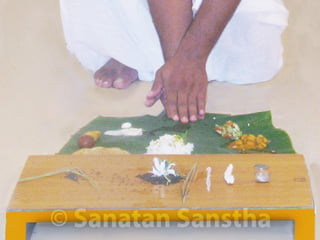 Method of serving food during Shraddha ritual
Method of serving food during Shraddha ritual Traditions observed in different countries for the liberation of deceased ancestors
Traditions observed in different countries for the liberation of deceased ancestors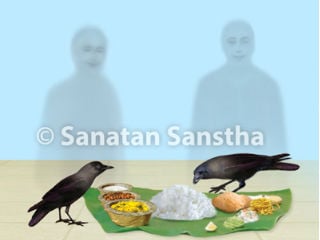 How to perform Mahalaya shraddha in Pitrupaksha during the Coronavirus pandemic ?
How to perform Mahalaya shraddha in Pitrupaksha during the Coronavirus pandemic ?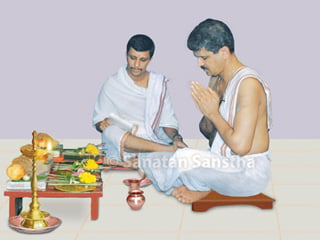 What are three historically established phases of Shraddha?
What are three historically established phases of Shraddha?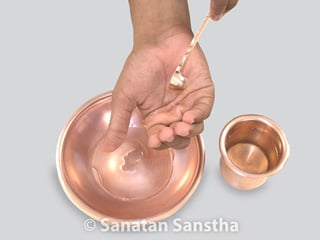 What is the method of performing Tarpan and Pitru tarpan ?
What is the method of performing Tarpan and Pitru tarpan ?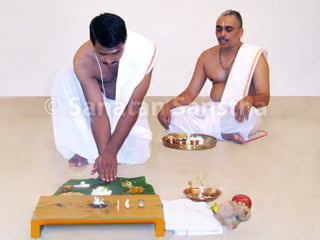 When should the Shraddha be performed ?
When should the Shraddha be performed ?